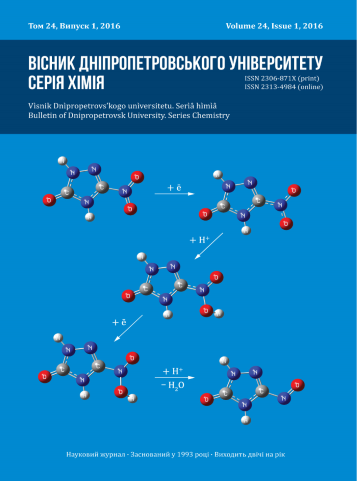Effect of polyelectrolytes on PbO<sub>2</sub> electrodeposition
DOI:
https://doi.org/10.15421/081603Keywords:
electrodeposition, polyelectrolyte, anode materials, electrocatalytic activityAbstract
Kinetic regularities of the electrodeposition of lead dioxide from electrolytes containing polyelectrolytes Drimax 1235 and Magnafloc manufactured by Ciba have been investigated. It was determined that the inhibition of the reaction of electrooxidation of Pb2+ with the decrease of a transfer coefficient without the changing of the mechanism of the process occurs in the presence of polyelectrolytes as additives in the deposition electrolyte. Observed effects depend upon the nature of the polyelectrolyte and probably caused by blocking of active sites on the surface of the growing oxide by adsorbed polyelectrolyte molecules. The use of polyelectrolytes as additives leads to a change in the catalytic activity of obtained materials in the reactions of oxygen evolution and oxidation of 4-chlorophenol.References
Feng, J., & Johnson, D. C. (1991). Electrocatalysis of anodic oxygen-transfer reactions: titanium substrates for pure and doped lead dioxide films. J. Electrochem. Soc., 138(11), 3328–3337.
LaCourse, W. R., Hsiao, Y.-L., & Johnson, D. C. (1989). Electrocatalytic oxidation at electrodeposited bismuth(III)-doped beta-lead dioxide film electrodes. J. Electrochem. Soc., 136 (12), 3714–3719.
Shao, Z., Yi, B., Zhang, X., & Zhang, E. (1997). Preparation of PbO2/Ti plate electrode. Dianhuaxue, 3(3), 319–324.
Shmychkova, O., Luk’yanenko, Т., Velichenko, A., Meda, L., & Amadelli, R. (2013). Bi-doped PbO2 anodes: Electrodeposition and physico-chemical properties. Electrochim. Acta, 111, 332–338.
Shmychkova, O., Luk'yanenko, T., Velichenko, A., & Amadelli, R. (2013). Electrodeposition of Ce-doped PbO2. J. Electroanal. Chem., 706, 86–92.
Velichenko, A. B., Amadelli, R., Benedetti, A., Girenko, D. V., Kovalyov, S. V., & Danilov, F. I. (2002). Electrosynthesis and physicochemical proerties of PbO2 films. J. Electrochem. Soc., 149 (9), C445-C449.
Shmychkova, O., Luk’yanenko, Т., Amadelli, R., & Velichenko, A. (2014). Рhysico-chemical properties of PbO2-anodes doped with Sn4+ and complex ions. J. Electroanal. Chem., 717-718, 196–201.
Trasatti, S., & Lodi, G. (1981) Oxygen and chlorine evolution at conductive metallic oxides. Electrodes of conductive metallic oxides. Part B. Amsterdam: Elsevier, 521–626.
Amadelli, R., Samiolo, L., De Battisti, A., & Velichenko, A. (2011). Electrooxidation of Some Phenolic Compounds by Electrogenerated O3 and by Direct Electrolysis at PbO2 Anodes. J. Electrochem. Soc., 158, P87–P92.
Amadelli, R., & Velichenko, A. (2001). Lead Dioxide Electrodes for High Potential Anodic Processes. J. Serbian Chemical Society, 66, 835–845.
Azzam, M. O., Al-Tarazi, M., & Tahboub, Y. (2000). Anodic destruction of 4-chlorophenol solution. J. Hazardous Materials, B75, 99–113.
Gherardini, L., Michaud, P. A., Panizza, M., Comninellis, Ch., & Vatistas, N. (2001). Electrochemical oxidation of 4-chlorophenol for wastewater treatment. J. Electrochem. Soc., 148 (6), D78–D82.
Downloads
Published
Issue
Section
License
Copyright (c) 2016 Oles Honchar Dnipropetrovsk National University

This work is licensed under a Creative Commons Attribution 4.0 International License.
- Authors reserve the right of attribution for the submitted manuscript, while transferring to the Journal the right to publish the article under the Creative Commons Attribution License. This license allows free distribution of the published work under the condition of proper attribution of the original authors and the initial publication source (i.e. the Journal)
- Authors have the right to enter into separate agreements for additional non-exclusive distribution of the work in the form it was published in the Journal (such as publishing the article on the institutional website or as a part of a monograph), provided the original publication in this Journal is properly referenced
- The Journal allows and encourages online publication of the manuscripts (such as on personal web pages), even when such a manuscript is still under editorial consideration, since it allows for a productive scientific discussion and better citation dynamics (see The Effect of Open Access).


